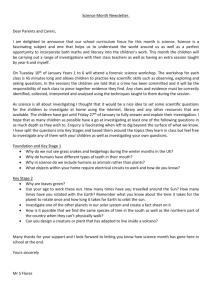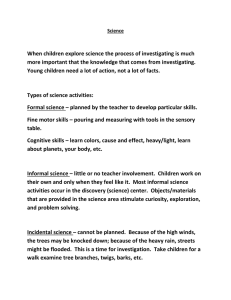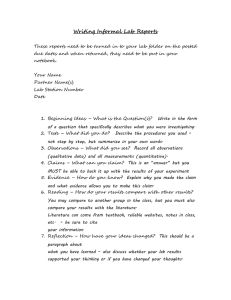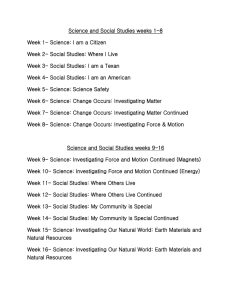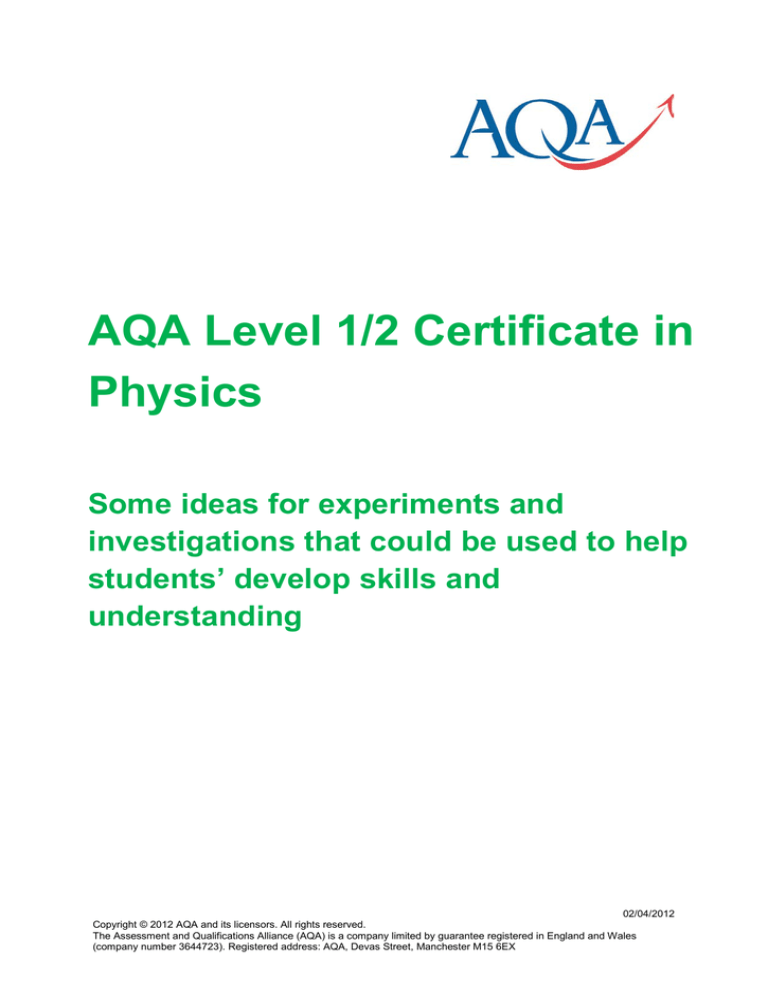
AQA Level 1/2 Certificate in
Physics
Some ideas for experiments and
investigations that could be used to help
students’ develop skills and
understanding
02/04/2012
Copyright © 2012 AQA and its licensors. All rights reserved.
The Assessment and Qualifications Alliance (AQA) is a company limited by guarantee registered in England and Wales
(company number 3644723). Registered address: AQA, Devas Street, Manchester M15 6EX
AQA Level 1/2 Certificate in Physics (Version 1.0)
It is the responsibility of the centre to be aware of any health and safety implications of the
investigation and ensure that a risk assessment for the practical is carried out. Teachers should
remind candidates about safe working when carrying out laboratory procedures.
1.1
•
•
•
•
1.2
•
•
•
1.3
•
•
1.4
•
•
1.5
•
•
•
2
Motion
Measurement of acceleration of trolleys using known forces and masses and an opportunity to
use data capture/light gates or ticker timer.
Measurement of the acceleration due to gravity using light gates or ticker timers.
Running trolleys down ramps of known height and finding velocity.
Investigating factors that determine the distance taken for a toy car to stop after rolling down a
ramp.
Resultant forces
Dropping a penny and a feather in a vacuum and through the air to show the effect of air
resistance.
Using a linear air track/trolleys down a slope, with ticker timer/light gates to establish
relationship between force and acceleration. Keeping the mass constant to show that force is
proportional to acceleration. Repeat for different mass trolleys.
Using a linear air track/trolleys down a slope, with ticker timer/light gates to establish
relationship between mass and acceleration. Keeping the force constant to show that
acceleration is inversely proportional to mass.
Momentum
Experiments to measure the momentum of a moving object.
Use of trolley/linear air track and light gate/ticker timer systems to measure momentum
conservation before and after an inelastic collision; and before and after a “gun and projectile”
event.
Forces and braking
Measuring reaction time with and without distractions, for example iPod off and then on.
Investigating factors that determine the frictional force between a block and a bench surface.
Forces and terminal velocity
Timing objects falling through a liquid, for example wallpaper paste or glycerine, using light
gates or stop clocks.
Dropping parachutes, paper spinners, cones or bun cases to investigate the effects of air
resistance.
Use of scales to measure the mass of objects in kilograms, then converting to weight in
newtons.
AQA Level 1/2 Certificate in Physics (Version 1.0)
1.6
•
•
•
•
•
1.7
•
•
•
•
•
1.8
•
•
•
1.9
•
•
•
•
1.10
•
Forces and elasticity
Hooke's law practicals.
Catapult practicals to compare stored energy.
Investigating factors that determine the bending of a beam.
Investigating factors that determine how much a spring stretches.
Investigating factors that determine the energy stored in a compressed spring.
Forces and energy
Investigating the transfer of E p to E k by dropping a card through a light gate.
Running upstairs and calculating work done and power, lifting weights to measure power.
A motor lifting a load to show how power changes with load.
Stretching different materials before using as catapults to show the different amounts of
energy transferred, indicated by speed reached by the object or distance travelled.
Investigating factors that determine the height to which a squash ball will bounce.
Centre of mass
Finding the centre of mass of an irregularly shaped card.
Investigating which factors affect the period of a simple pendulum (mass, length of pendulum,
amplitude of swing).
Investigating objects and slopes to find out the point at which the object topples.
Moments
Investigating the turning effect of a force.
Using a balanced metre ruler and masses to verify the principle of moments.
Using a balance beam and the principle of moments to measure an unknown weight.
Measuring the weight of a beam.
Circular motion
Whirling a bung on the end of a piece of string to demonstrate the factors which affect
centripetal force.
3
AQA Level 1/2 Certificate in Physics (Version 1.0)
1.11
•
•
•
2.1
•
•
•
•
•
2.2
•
•
•
•
•
•
•
2.3
•
•
•
•
•
•
•
•
4
Hydraulics
Demonstrating that pressure in liquids acts in all directions using a circular container with
holes around it.
Measuring the pressure a person/range of objects applies.
Demonstrating a hydraulic jack lifting a person, placed on a board, off the ground.
General properties of waves
Demonstrating and modelling wave energy transfer without transfer of matter using a
“Mexican Wave”.
Demonstrating transverse and longitudinal waves with a slinky spring.
Using a class set of skipping ropes to investigate frequency and wavelength.
Using a ripple tank to demonstrate reflection, refraction, diffraction and interference.
Using signal generator and two speakers to demonstrate interference in sound waves.
The electromagnetic spectrum
Investigating the range of Bluetooth or infrared communications between mobile phones and
laptops.
Using a 3 cm wave kit to demonstrate that microwaves can be reflected, refracted and
diffracted.
Use of a microwave oven to cook popcorn to illustrate the heating effect of microwaves.
Use of a remote handset to demonstrate infrared reflection.
Use of a remote handset, a 3 cm wave kit and a gamma source with Geiger Counter to
investigate penetration ability through a range of materials.
Demonstrating diffraction of light by looking at a low intensity light source through a narrow
aperture or through a diffraction grating.
Demonstrating the lighting of a phosphorus match using a radiant heat (infrared) source set at
the focal point of a large concave mirror.
Sound and ultrasound
Use of bell jar to demonstrate that sound cannot travel in a vacuum.
Using the echo technique to calculate the speed of sound in air or measuring the speed of
sound by resonance.
Demonstrating the range of frequencies audible to the human ear, using a signal generator,
loudspeaker and oscilloscope.
Use of tuning forks to demonstrate a range of different frequency sounds.
Displaying sounds as a waveform on an oscilloscope using a microphone.
Use of a signal generator and oscilloscope with different time base settings to work out
period/frequency.
Using a signal generator and two speakers to demonstrate interference in sound waves.
Use of a sound level meter to investigate the intensity of a range of sounds.
AQA Level 1/2 Certificate in Physics (Version 1.0)
2.4
•
•
•
2.5
•
•
•
•
2.6
•
•
•
•
•
2.7
•
3.1
•
•
•
•
•
•
Reflection
Reflecting light off a plane mirror at different angles.
Finding the position of an image in a plane mirror using no parallax.
Investigating lateral inversion of letters, words and shapes using a plane mirror.
Refraction and total internal reflection
Carrying out refraction investigations using a glass block; including calculation of critical
angle.
Calculating the refractive index of glass and perspex blocks by measuring angles or using the
apparent depth method.
Carrying out investigations using ripple tanks, including the relationship between depth of
water and wave speed.
Investigating total internal reflection using a semi-circular glass block.
Lenses and the eye
Use of prisms and a glass block to model the action of a converging and diverging lens.
Investigating the action of a converging and diverging lens on rays of light.
Finding the focal point of a range of converging convex lenses by producing a real image on a
screen from a distant object or by using the no parallax method.
Using a round-bottomed flask filled with a solution of fluorescein to represent the eye.
Demonstrating long and short sight by placing a screen, not at the focal point, and rectifying
the image through the use of appropriate lenses.
Red-shift
Demonstrating the Doppler effect for sound.
Kinetic theory
Demonstration using balls in a tray to show behaviour of particles in substances in different
states.
Experiment to determine the melting point of a solid and the boiling point of a liquid.
Using immersion heaters in a metal block to measure specific heat capacity.
Using the method of mixtures to determine the specific heat capacities of substances.
Demonstration of a method to determine specific latent heat of vaporisation.
Demonstration of a method to determine specific latent heat of fusion.
5
AQA Level 1/2 Certificate in Physics (Version 1.0)
3.2
•
•
•
•
•
•
•
•
•
•
•
3.3
•
•
•
3.4
•
•
•
3.5
•
•
6
Energy transfer by heating
Measuring the cooling effect produced by evaporation; putting wet cotton wool over the bulb
of a thermometer or temperature probe.
Investigating the factors that affect the rate of evaporation of a liquid.
Investigating factors that affect the rate of cooling of a can of water, for example shape,
volume and colour of can.
Investigating thermal conduction using rods of different materials.
Ignition point of a gas using gauze.
Investigating materials that are poor conductors/good insulators.
Demonstrating convection in liquids using a convection ring and in gases using a convection
chamber.
Demonstration of embers in convection current or a convection spiral or Chinese lantern.
Investigating surface area and heat loss using (same shape) round-bottomed flasks.
Demonstration experiments including ball and ring, expansion bar and bi-metallic strips.
Investigating the expansion of different liquids inside a capillary tube.
Infrared radiation
Using Leslie’s cube to demonstrate the effect on radiation of altering the nature of the surface.
Use of a thermopile to monitor thermal energy output from each surface.
Using Leslie’s cube to demonstrate the effect on radiation of altering the temperature of the
water inside the vessel and use of a thermopile to monitor thermal energy output from each
surface.
Use of dark/matt and silver/shiny vessels to investigate absorption and emission of thermal
radiation from surfaces.
Energy transfers and efficiency
An energy ‘circus’ to demonstrate various energy transfers and identify useful and wasted
output energies.
Investigating the efficiency of an electric motor or a car jack lifting a load.
Investigating energy loss in a ball bounce or bungee.
Heating and insulating buildings
Constructing a model house, using sensors and data loggers to measure temperatures with
and without various types of insulation.
Investigating the factors that determine rate of heat loss.
AQA Level 1/2 Certificate in Physics (Version 1.0)
4.1
•
•
•
•
•
•
•
•
•
•
4.2
•
•
•
•
•
•
•
4.3
•
•
•
4.4
•
•
Electrical circuits
Using filament bulbs and resistors to investigate potential difference/current characteristics.
Setting up series and parallel circuits to investigate current and potential difference.
Finding the resistance of an unknown standard resistor using an electric circuit.
Investigating potential difference/current characteristics for LDRs and thermistors.
Investigating the potential difference/current characteristics for a diode, filament lamp and a
standard resistor.
Investigating how light level affects resistance of an LDR.
Investigating how temperature affects the resistance of a thermistor.
Investigating factors that determine the resistance of a piece of wire.
Investigating the heating effect of an electrical current.
Investigating energy loss for a range of 12 V filament lamps.
Household electricity
Measuring oscilloscope traces varying the voltage and time base. There are virtual
oscilloscopes available via the internet.
Demonstrating a transformer to show the difference between using d.c. and a.c.
Demonstrating the action of fuse wires.
Investigating the factors that determine the current needed to melt a fuse.
Demonstrating the wiring structure of an appliance with 2 and 3 core wiring.
Demonstrating an appliance that is double insulated.
Candidates reading the electricity meter at home on a daily or weekly basis. They could then
look for trends in usage and try to explain these, for example in terms of weather conditions.
Transferring electrical energy
Measuring the power of 12 V devices by measuring energy transferred (using a joulemeter or
ammeter and voltmeter) in a set time.
Using an electrical joulemeter to investigate the energy transferred by low voltage bulbs of
different powers, low voltage motors and low voltage immersion heaters.
Surveying a range of electrical devices, recording useful and wasted energy.
The National Grid
Investigating a step-up and step-down C-core transformer.
Modelling the National Grid.
7
AQA Level 1/2 Certificate in Physics (Version 1.0)
5.1
•
•
•
•
•
•
•
•
5.3
•
•
•
•
•
•
6.1
•
.6.2
•
•
•
•
•
•
6.3
•
8
The motor effect
Using iron fillings to map the magnetic field around a magnet and to show how the magnetic
fields interact at like and unlike poles.
Using an overhead projector to demonstrate, using transparent compasses, magnetic fields
around a straight and coiled wires that are carrying an electric current.
Investigating the factors that determine the strength of an electromagnet.
Making a magnet by placing steel bar into a solenoid.
Investigating the motor effect by placing a foil strip with a current going through it in a strong
magnetic field.
Building a motor.
Making a loudspeaker.
Making a model ammeter.
Transformers
Investigating the generator effect by “cutting” a foil strip across a strong magnetic field. The
foil strip (via leads) is connected to a deflection beam galvanometer.
Demonstrating a model motor connected to a deflection beam galvanometer as a generator.
Investigating how a simple 6 V d.c. motor can be used as a generator.
Use of deflection beam galvanometer to investigate the generator effect by moving a magnet
through a coil of wire in different directions then moving the coil of wire across the magnetic
field of the magnet.
Making a transformer using C-cores and insulated wire.
Demonstration of transformer operation using a transformer kit.
Atomic structure
Using hot-cross buns to show the plum pudding model.
Atoms and radiation
Heating popcorn in a pan to illustrate the random nature of radioactive decay.
Using Geiger counters to measure the penetration and range in air of the radiation from
different sources.
Demonstrating the use a cloud chamber to observe the affect of an electric field on the path of
alpha particles.
Using dice to demonstrate probabilities involved in half-life.
Demonstrating the use of a Protactinium Generator with a Geiger counter to monitor count
rate over a short time to calculate the half life.
Demonstrating why a beta source is used to control the thickness of paper.
Nuclear fission
Using domino tracks for fission/chain reactions.

